Creating a beautifully layered space that feels curated yet cohesive is an art form. It’s not just a passing trend but an enduring characteristic of a well-designed room. While purchasing a matching furniture set feels safe and ensures uniformity, it often lacks depth and character. As designers, we skillfully mix and match furniture styles, materials, and textures to achieve a look that is dynamic, inviting, and rich in personality.The concept of mixing and mismatching furniture has been around for centuries. Historically, people have combined furniture out of necessity, sentimentality, or an appreciation for diverse design influences. In the 17th century, wealthy British travelers who visited the Orient brought back or commissioned furniture and porcelain inspired by Chinese design, leading to the development of the Chinoiserie style—a trend that remains popular today. Throughout history, homes have reflected a mix of eras and influences, proving that blending styles isn’t just possible; it’s desirable.
More important than the historical context of mixing furniture styles is the personal creativity it allows. Once you understand that nothing needs to match perfectly, you unlock the freedom to design spaces that reflect your personality. In fact, over-matching can make a room feel sterile and uninspired. But how do you successfully mix and match furniture while maintaining harmony?
Here are our top 10 tips from the pros at Nandina on how to ditch the desire to match and embrace the beauty of the mix!
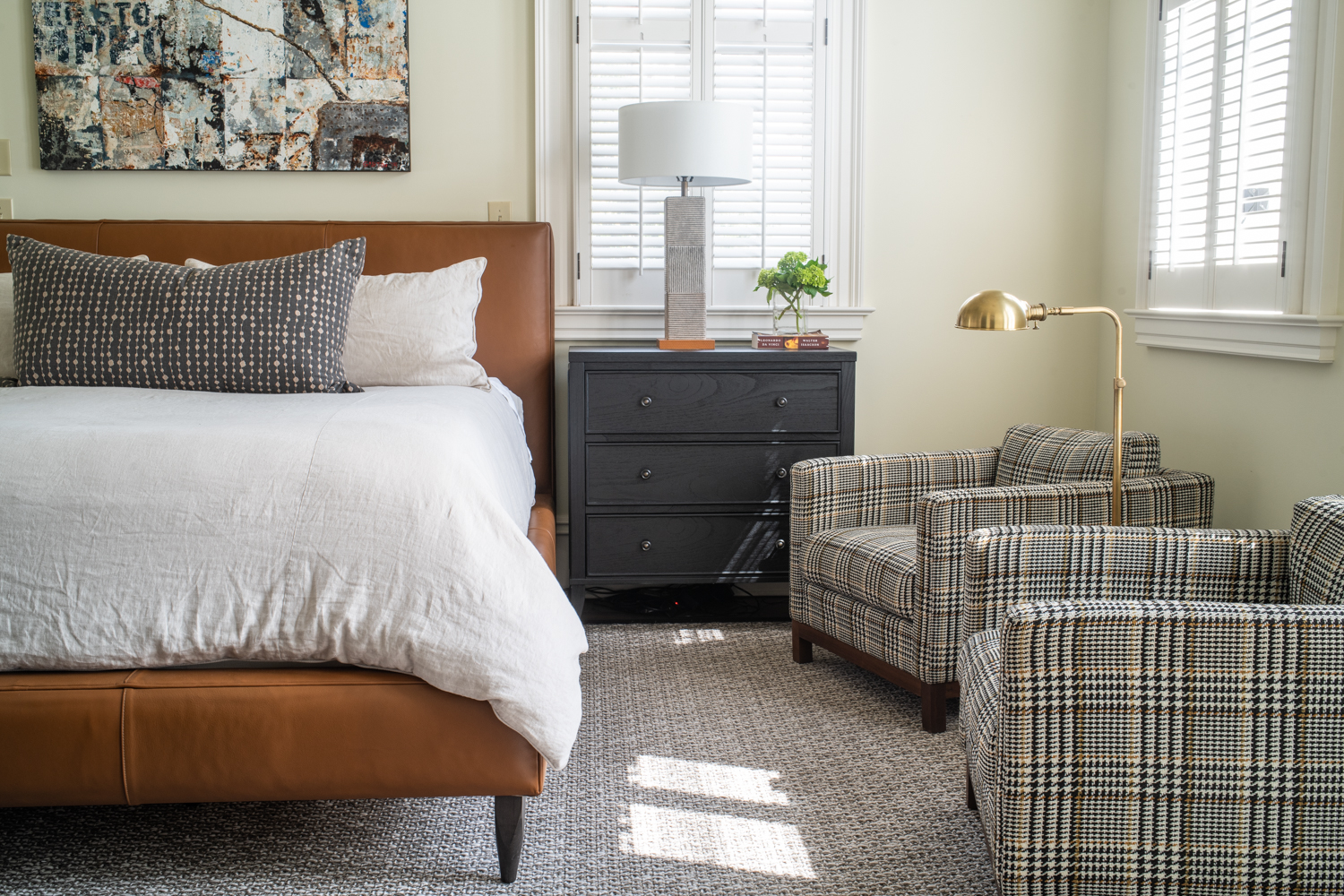
This sophisticated bedroom is a perfect example of mixing furniture colors and styles to achieve a cohesive design full of character. The carmel leather bed pairs well with a black stained bedside chest and the plaid upholstered club chairs tie the entire design together. Design By: Ashley Diggelmann, Nandina Greenville , Photography: Shelly Marshall Schmidt
Start with a Cohesive Color Palette
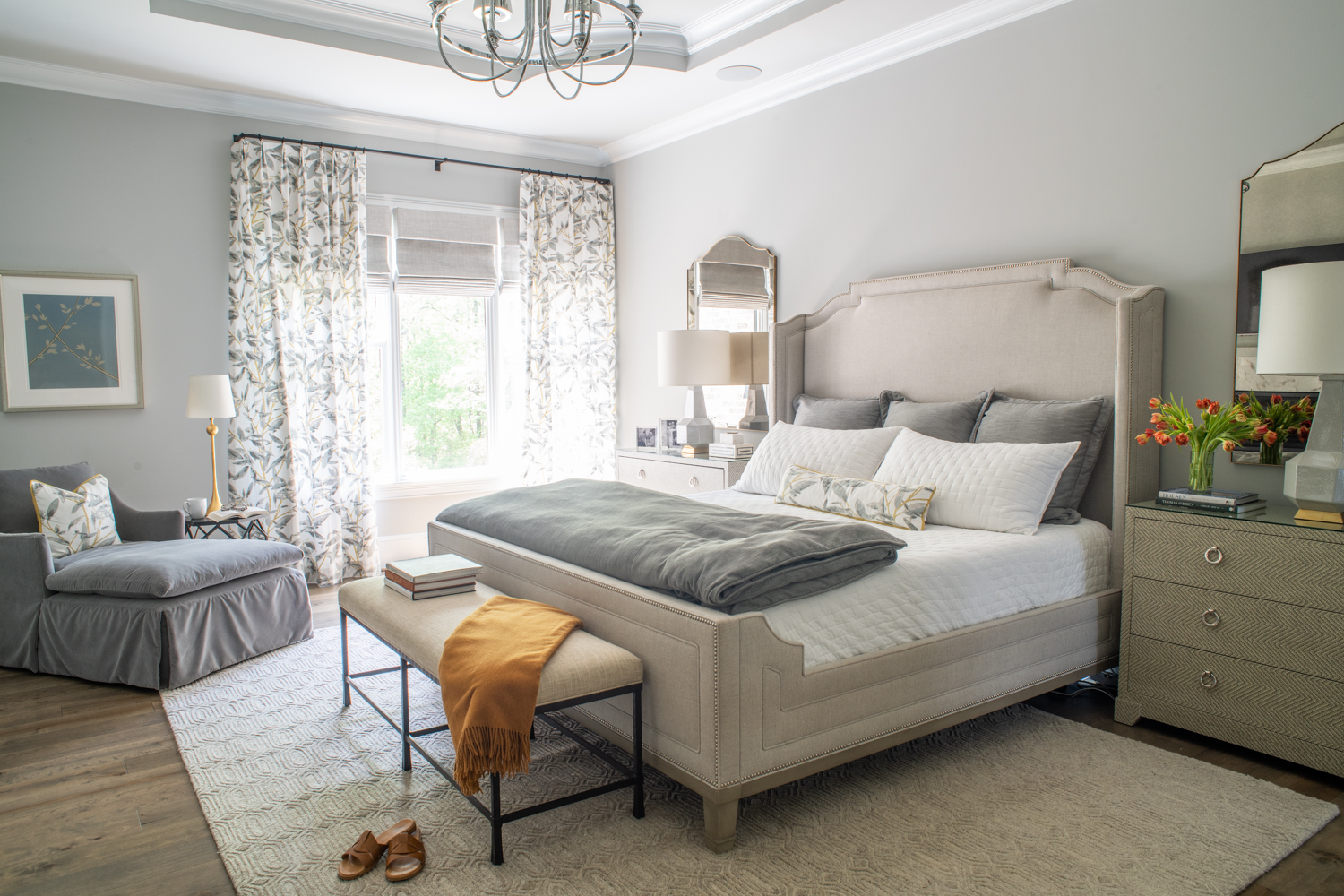
A soft pallet of warm grey and light blue, ties together a mix of furnishing and drapery pattern in this serene bedroom. Pop’s of orange and coral in accessories keeps the design interesting. Design by: BethAnn Connor, Nandina Greenville, Photography: Shelly Marshall Schmidt
A well-defined color scheme helps unify different furniture pieces, even when they vary in style, shape, or era. Neutrals with pops of accent colors create harmony, while tonal layering—using varying shades of the same hue—adds depth. For example, in a bedroom, a white upholstered bed pairs beautifully with dark wood bedside tables and a painted white dresser. In a living room, navy blue velvet chairs can complement a leather sofa when tied together with patterned pillows featuring shades of both colors.
Mix Materials and Textures
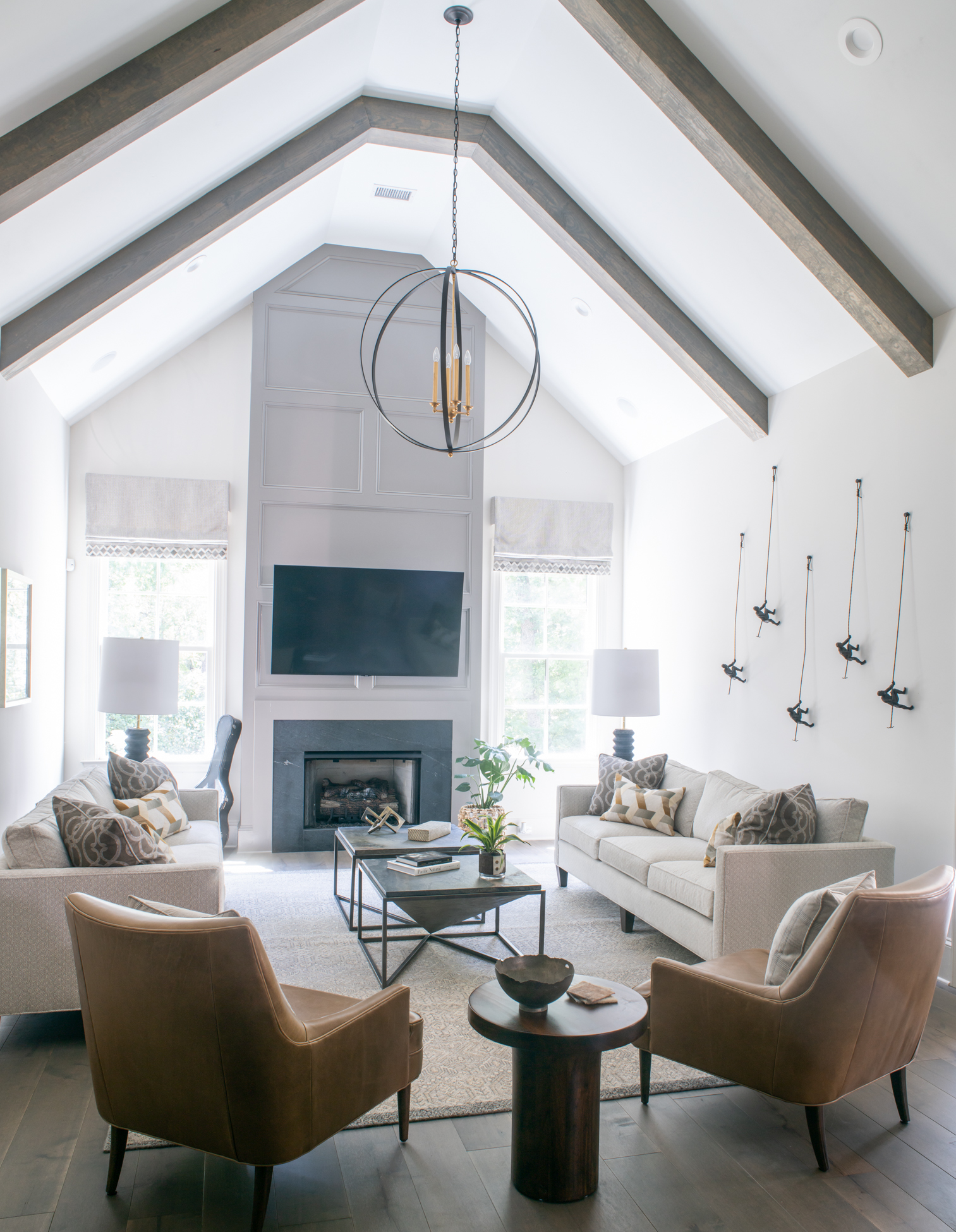
Metal, leather, upholstery, wood and stone mix comfortably in this great room adding visual and tactile richness. Design by: Michele Merritt, Nandina Aike Photography: Shelly Marshall Schmidt
A room with only one material can feel flat, so mixing wood, metal, glass, stone, and upholstery creates visual and tactile richness. Consider pairing a sleek leather sofa with a rustic wooden coffee table and a soft wool rug to balance contrast and warmth. Too much of one wood tone—whether oak, pine, or mahogany—can make a space feel monotonous. Instead, contrast an antique pine coffee table with modern metal and glass side tables. The interplay of materials prevents a room from feeling predictable.
Balance Old and New
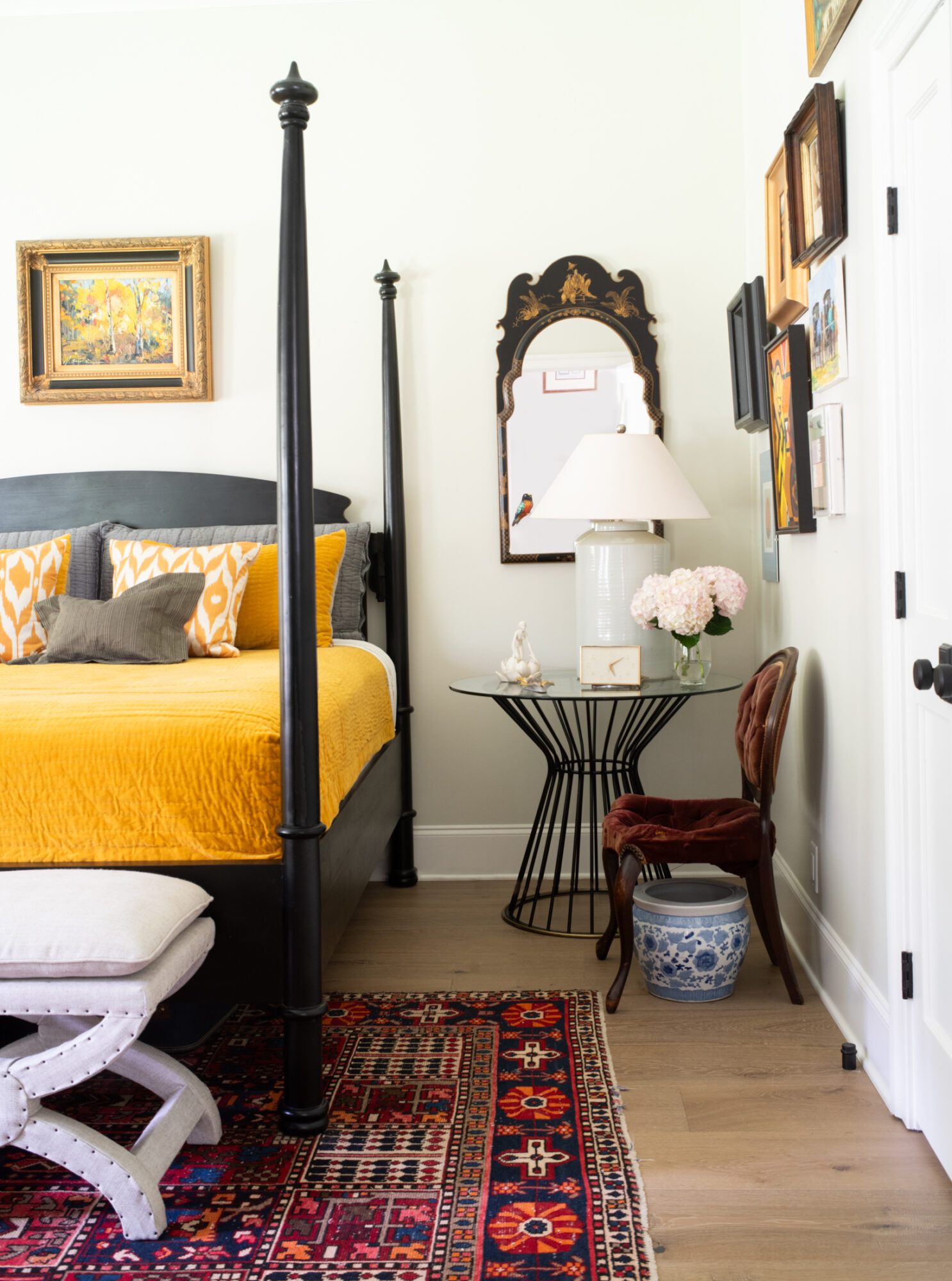
An antique chair surrounded by a gallery wall of vintage art sits easily next to a modern metal table and a bold black four poster bed with an antique hand-knotted rug covering the floor. This mix of old and new adds a layered richness to this eclectic bedroom design. Design by: Christina Scharf, Nandina Aiken Photography: Shelly Marshall Schmidt
A thoughtfully mixed room combines vintage and contemporary elements to avoid looking one-dimensional. If your space has primarily modern pieces, introduce an antique console table or a vintage Persian rug for character. Conversely, a traditional dining table can feel fresh with modern chairs. Don’t hesitate to mix a hand-painted French antique dresser with a sleek four-poster bed—the French have mastered this effortlessly chic approach for centuries!
Play with Scale and Proportion
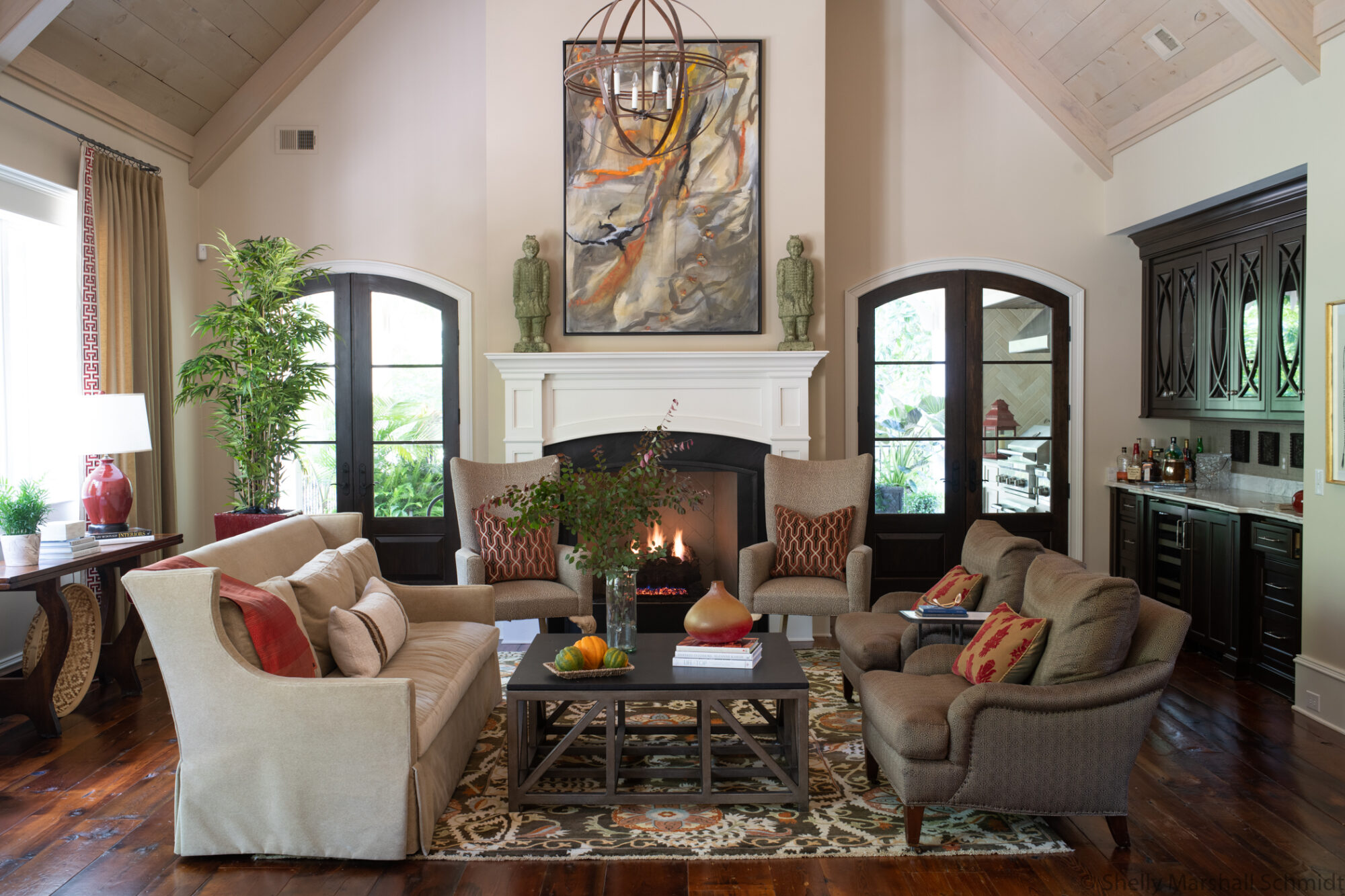
Furnishing a room with a high peaked ceiling can be challenging, but artfully mixing the heights, shapes, and sizes of the furnishings and fixtures can humanize the scale of the room. High-backed modern wing chairs flank a massive stonecast fireplace. An oversized piece of modern art along with a large sphere chandelier balance the weight of the arched doors and large dark stained bar area. Design by: Sue Shannon, Nandina Aiken Photography: Shelly Marshall Schmidt
Varying furniture heights, shapes, and sizes ensures a balanced, engaging space. A tall bookshelf next to a low-profile sofa creates an appealing contrast, while a mix of large and small pieces prevents the room from feeling too uniform. When choosing furniture, consider the visual weight of each item; for instance, a heavy wooden coffee table can be counterbalanced by airy, open-frame chairs or glass-topped side tables.
Unify with Repeating Elements
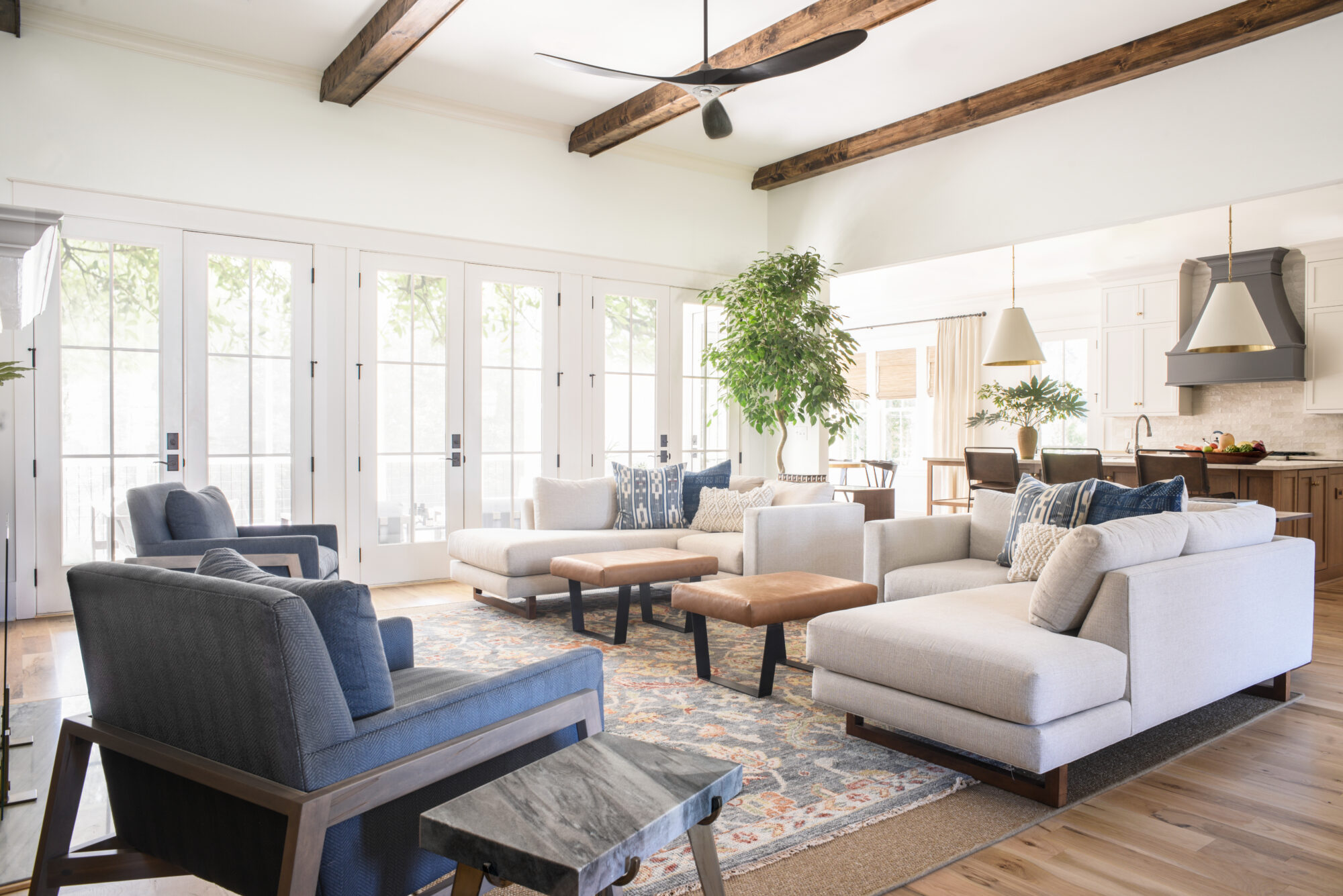
This great room is a study in symmetry and the use of repeating elements to tie together a mix of furniture and design elements. Metal, wood and leather are repeated in the beams, base of the matching upholstered sectionals, duel leather ottomans and the frames of the club chairs. Design By: Susan Victor, Nandina Aiken Photography Shelly Marshall Schmidt
Even in an eclectic room, certain repeating elements provide a sense of cohesion. If you have a beautiful walnut sideboard, introduce walnut accents elsewhere, such as in a chair frame or floating shelves. Similarly, repeating metal finishes—like brass hardware on furniture and lighting fixtures—creates harmony without being overly matchy. Black metal in a bookshelf, pendant lights, and table legs can subtly tie different pieces together.
Use Statement Pieces as Anchors
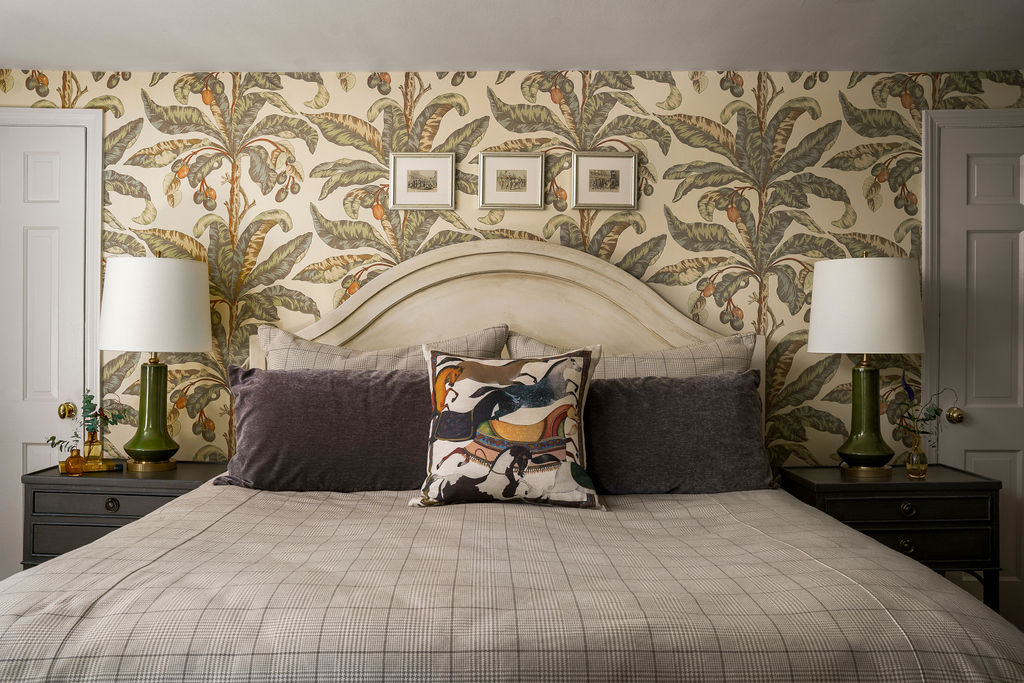
The use of a bold colorful wallpaper is the focal point of the design of this beautiful primary suite. Design by: Michele Merritt, Nandina Aiken Photography: Megan Padgett
A statement piece serves as the anchor for the room, drawing the eye and allowing other elements to complement it without feeling chaotic. A bold velvet sofa, a vintage armoire, or an amazing wallpaper can be the focal point around which the rest of the furniture revolves. For example, placing an antique gold Baroque mirror above a modern Parsons-style console table creates an elegant juxtaposition that immediately elevates a living room or entryway.
Layer in Accessories and Soft Elements
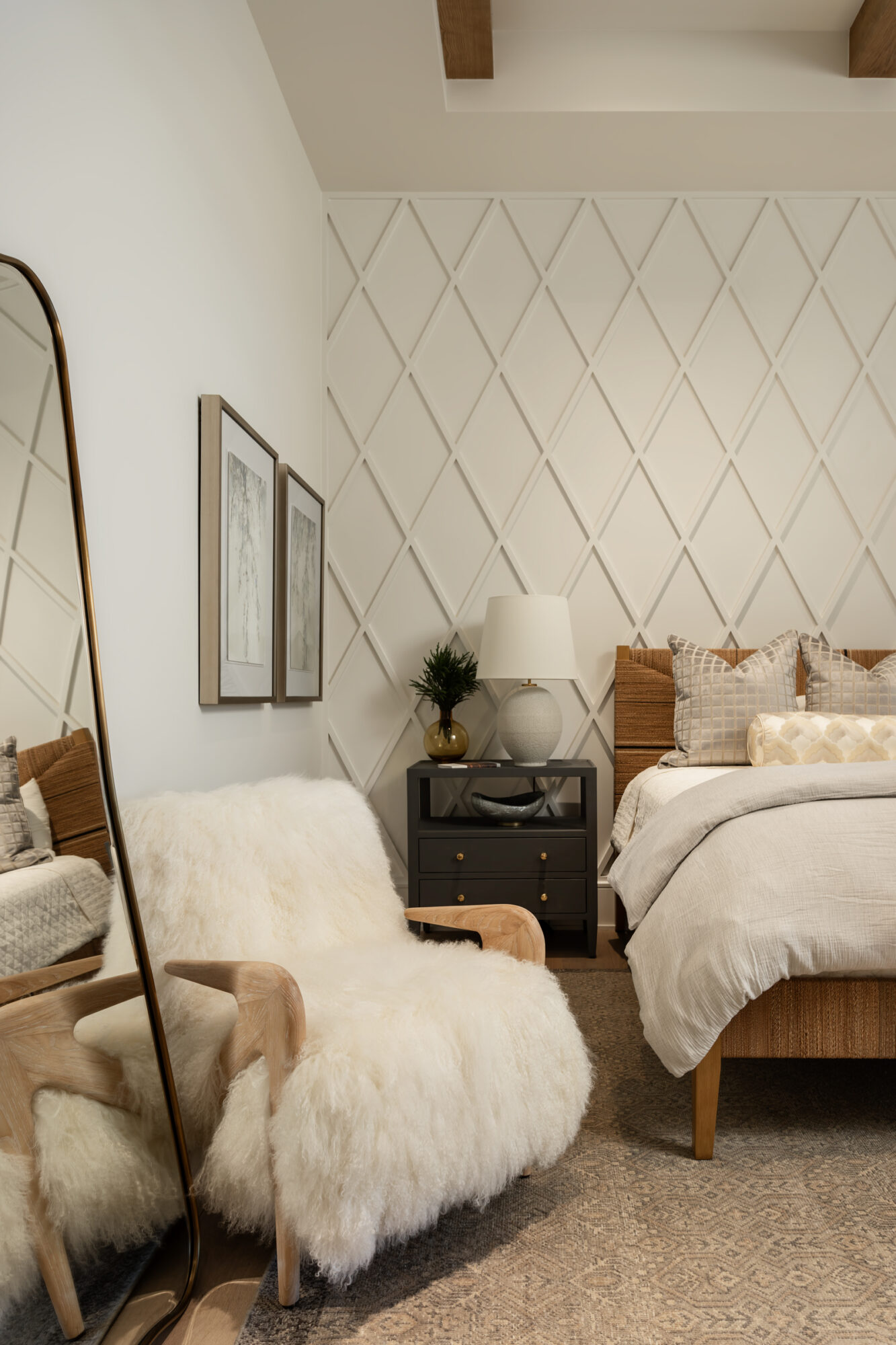
A large floor length mirror and a fur covered chair tie together this neutral room by adding texture and reflection. Design by: BethAnn Connor and Ashley Diggelmann, Nandina Greenville Photography Inspiro 8 Studio
Accessories, textiles, and décor play a crucial role in tying together mixed furniture styles. Rugs, throw pillows, and curtains add softness and dimension, while books, sculptures, and plants infuse personality. Layering elements like textured throws on a leather sofa or a patterned rug under a minimalist coffee table helps bridge different styles, making the space feel intentional and lived-in rather than disjointed.
Personalize with Meaningful Pieces
At the end of the day, a well-designed home should reflect the people who live in it. Incorporate furniture that has sentimental value—perhaps a grandmother’s antique chair or a unique thrifted find. Mixing these meaningful pieces with contemporary furnishings creates a space that feels collected over time rather than designed in one go. Homes with personality tell a story, making them far more inviting and interesting.
Don’t Be Afraid to Experiment
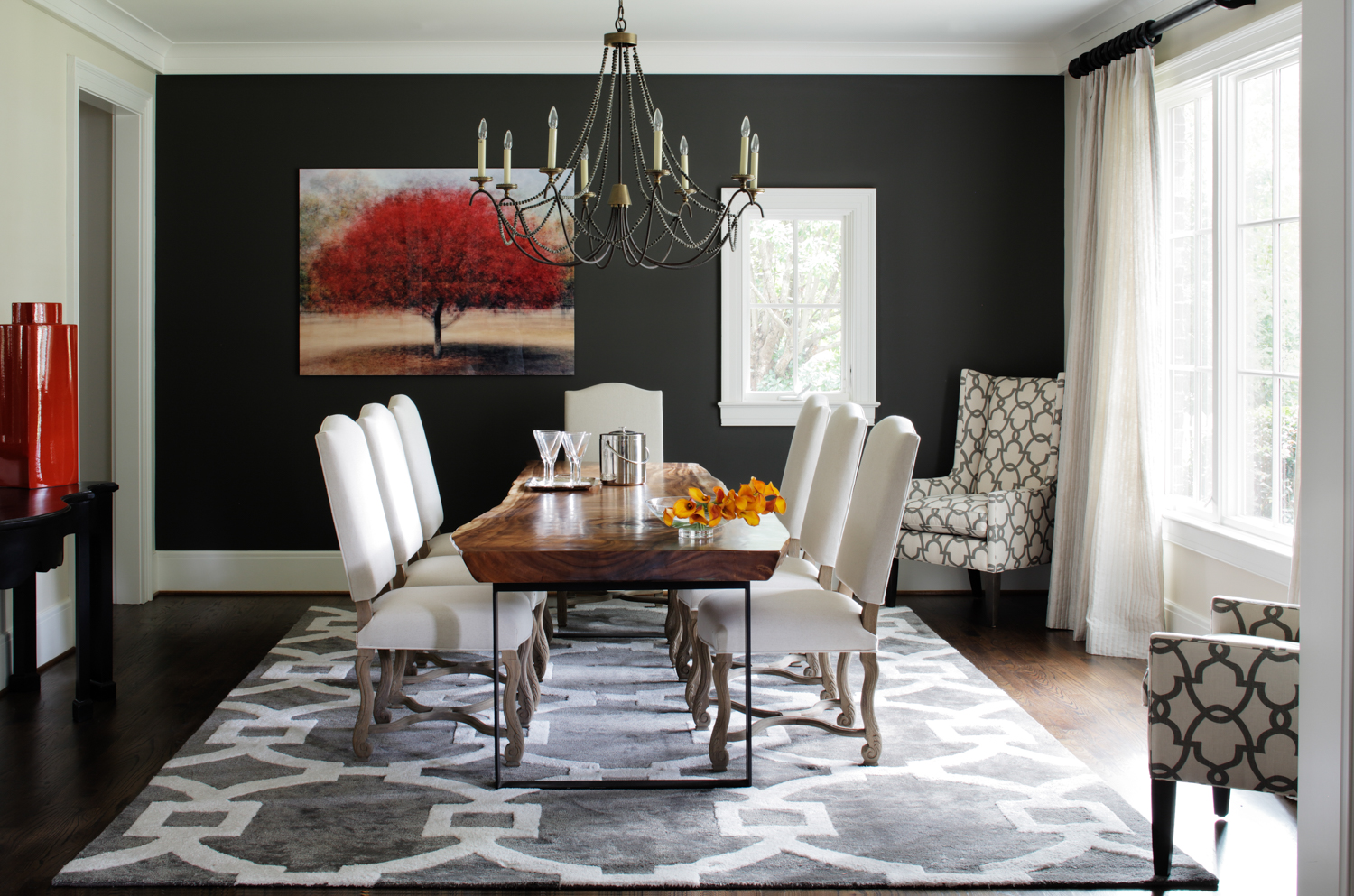
Vintage style dining chairs are paired with a modern live edge dining table and a French inspired beaded chandelier for a layered mix of styles. The bold black accent wall is the perfect foil to the bright red art and accents. Design by: John Ishmael, Nandina Atlanta
If you’re hesitant to commit to mixing styles, start small. Swap out traditional dining chairs for a mix of upholstered and wooden options. Try placing a vintage cabinet in a modern space and see how it changes the dynamic. Interior design is about experimentation—sometimes unexpected combinations create the most stunning results.
Trust Your Instincts
Finally, trust yourself! While these guidelines help create balance, the best design choices are often instinctual. If a combination feels right to you, embrace it! Homes that reflect individual style are always the most successful because they resonate on a personal level.
Conclusion
By following these principles, designers craft interiors that feel intentional, layered, and effortlessly stylish. Whether you’re decorating from scratch or refreshing a space, mixing and matching furniture the right way results in a home that is not only sophisticated but also uniquely yours. So go ahead—ditch the perfectly matched set, embrace the mix, and create a space that feels collected, personal, and full of character!




